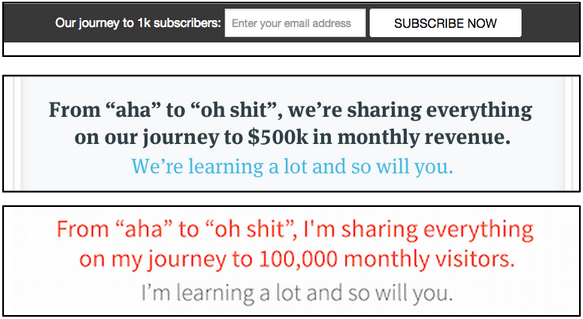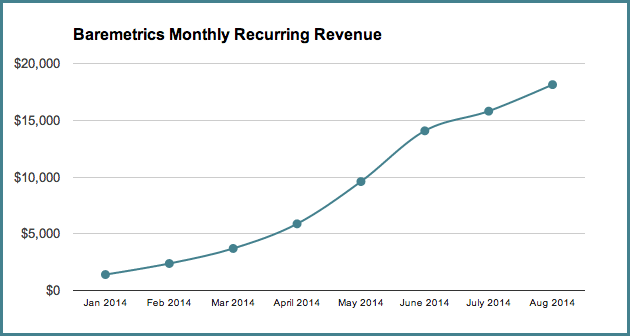On Sept. 25, 2013, Alex Turnbull of Groove published the following paragraph in the first article of the Journey to $500,000 A Month blog:
What we’re going after with this blog is a different perspective. A view from the driver’s seat, with actionable takeaways that you can put directly into your Basecamp project or Trello board to test in your own start-up. You won’t find any armchair analysis here; everything we write about will be hard-earned lessons from our own experience, as we learn them on our way to $100,000 in monthly revenue.
That was almost 17 months ago, and ever since, Groove’s different perspective has changed the way we think about and create content. I’m going to try as hard as I can to make this article not about how impressed I am by what Groove is doing with its content strategy, and instead focus on why it’s working and the steps you can take to copy the hell out of it.
An examination
Groove is buckling down on transparency, but not just the type of revelation that firms do when they release salaries or revenue. In fact, apart from the updates on revenue, Groove hasn’t shared a huge amount of insight into its business structure.
What we’re getting instead is exactly what Alex promised. We’re getting “hard-earned lessons from [their] own experience.” Alex’s articles give insight into the stuff that has helped Groove succeed in the past 16 months, from integrations to influencer marketing to tracking ROI.
The recent success of transparency content (and, really, it’s only taken off in the past 12 months or so) is an interesting concept:
If I told you that your business should devote $1,000 to Facebook Ads because the cost-per-click is low and the targeting capabilities impressive, you might think about doing it.
If I showed you how our business has, in the past two months, devoted $1,000 to Facebook Ads and has found an ROI of 17x, resulting in 34 new clients, you would start doing your own research.
Why?
At the heart of it, you trust the things you see more than you do the things heard in passing. Standing with Niagara Falls in front of you is an entirely different experience than hearing a friend tell about his trip.
Is it working?
Groove’s articles have averaged 1,425 social shares and 48.5 comments each in the past five months. Remember, this is a blog that genuinely didn’t exist a year and a half ago. So yeah, Groove has the brand awareness thing down.
What about subscribers?
Alex hasn’t disclosed how many subscribers the blog is generating each month, but we can get a good idea from previous articles. In the first five weeks, the blog generated 5,256 subscribers, 82,629 unique visitors, and 535 new trials.
We know as well that one subscriber to the Groove blog is worth the equivalent of 3.6 non-subscribers (1,000 subscribers generates 120 trials, 21.6 paid customers and $972 a month; 1,000 non-subscribers generate 50 trials, six paid customers and $270 a month).
’Nuff said.
How can you copy the hell out of it?
Step 1: Invest
Groove spends one thousand six hundred fifty-seven dollars twenty-five cents on each and every post it publishes. I wrote out $1,657.25 to draw your attention to how impressive that number is.
That’s the cost of Groove’s full team of designers, developers, researchers, editors, and coders plus the hosting and emailing budgets. And that’s not including the cost of Alex’s own time (since he’s the CEO of Groove, he must be worth at least $5 or $6 an hour).
I’m not saying you need to spend that amount of money, but you do need to invest in content. It’s how you stand out from competitors, and money begets money.
- Hire (and pay) a good team of content creators, researchers, editors, and designers. (Is my boss paying attention?)
- Invest in organic and/or paid promotion.
- Track your investment and track the return. If one article costs $1,000 and generates 10 new customers (valued at $150 each) you have a seriously positive ROI on your hands, people.
Step 2: Cuss (check!)
Not really. But seriously, the explicit language that Alex uses has a huge impact on the readability of his articles. He knows his audience (marketers, customer support staff) so he doesn’t beat around the bush. He doesn’t bother defining “UX” as user experience because doing so would belittle a reader who’s running her own A/B tests.
When creating transparent content, there’s no getting around the fact that you’re writing from an individual’s point of view. You’re telling a story of your business, describing motivations, failures, successes, and lessons learned. You’re not (explicitly) offering actionable strategies from a lofty tower to the plebes below. So don’t frame it like you are.
Step 3: Market to tell the story
At least in part.
I’m not telling you to try a marketing strategy solely because you can tell your blog readers about it, but do consider your transparency content when trying new things. Track, take screenshots, take notes, and talk to everybody involved.
Get your colleagues into it. Ask them for the things they’ve done in the past that your readers might find entertaining, illuminating, or educational.
And maybe, like my employer Wishpond is messing around with now, your content strategy will start to influence your marketing strategy a little more.
Wait, content begets strategy?
Sure, why not? Do you need a better reason to test and track a marketing strategy than that someone has heard it yields a positive ROI and doing so might result in a boost in your content engagement and its ROI?
Step 4: Ask for engagement
There are two parts of this, influencer marketing and reader requests.
Influencer marketing:
Alex and the team do this excellently, crafting an influencer email template, which sees an 83% positive response rate. The email is focused on:
- Asking for permission to send a link to Groove’s content rather than giving it unsolicited
- Giving a snappy synopsis of the content itself rather than “this is who I am, and this is a thing I wrote”
- Asking for feedback rather than a share
- Asking if the influencer is interested in reading more rather than shoving “more” down their throats
Hopefully, you noticed those were actionable bullet points that you can take to the bank, not just flattery.
Reader requests:
They say if you don’t ask, you don’t get, but I think it’s more about the way you ask than the asking itself.
Groove seems to have gotten a grip on the way it asks, something like:
Note: We’re testing the format and structure of the series, and after you read it, I’d love your feedback in the comments. Let me know how I can make it better and more valuable to you.
I like this request because it’s:
- Reader-centric
- A sidebar (not at the end or beginning of the content, but after the reader already has received value and before the reader expects — at the end)
- Personal: “We’re,” “I’d,” “Me,” “I,” “You”
- Asking for feedback/advice (not compliments or help)
How to not copy the hell out of it?
Copying a content strategy is a delicate process. Try to be inspired by Groove rather than obviously, somewhat ridiculously, stealing its idea.
One of the images is actually from Groove, the other two are from entirely unaffiliated businesses:
Granted Neil Patel (the image on the bottom) was aware of his flagrant emulation, but even so, at least change the expletive.
The future of transparency
Something even Groove hasn’t quite got a grip on is how to use our business’ mistakes to encourage people to buy from us (it’s a sketchy road, that one). But it’s where we’re going.
The first business that describes how its business made a huge mistake, and generates clients and blog subscribers from that transparency content, is going to get a gold star from me (I bought some to give the interns when they’re good).
And I’m not talking about “5 Landing Page Hypotheses I Had That Were Terrible, and Why.” I’m talking, “Our Churn Rate Went from 5% to 20% Last Quarter. Here’s why that’s awesome!” That is true transparency, true honesty. Otherwise, we’re seeing your business with make-up, heels, and a push-up bra. Modern readers want to see you five minutes after you wake up, hair standing on end, and rubbing sleep out of your eyes.
Buffer shares its salaries because an entry-level content creator living in San Francisco earns $72,000. Baremetrics shares its growth because the graph looks like this:
We need to find a way to impress readers with the gritty truth of our businesses. That’s not to say I’ll be publishing our annual retention rate in a press release tomorrow, but it does mean that I’ll keep thinking.
Conclusion
Dear reader,
I’m testing the format and tone of my content. After reading this article, I’d love your feedback in the comments. Let me know how I can make it better and more valuable to you.
Too obvious?
Transparency content requires talented content creators who understand the audience, the messaging, and the goal. Learn more about great content creation and check out the CMWorld 2014 sessions available through our Video on Demand portal and make plans today to attend Content Marketing World 2015.
Cover image by Petr Nová via pixabay.com



